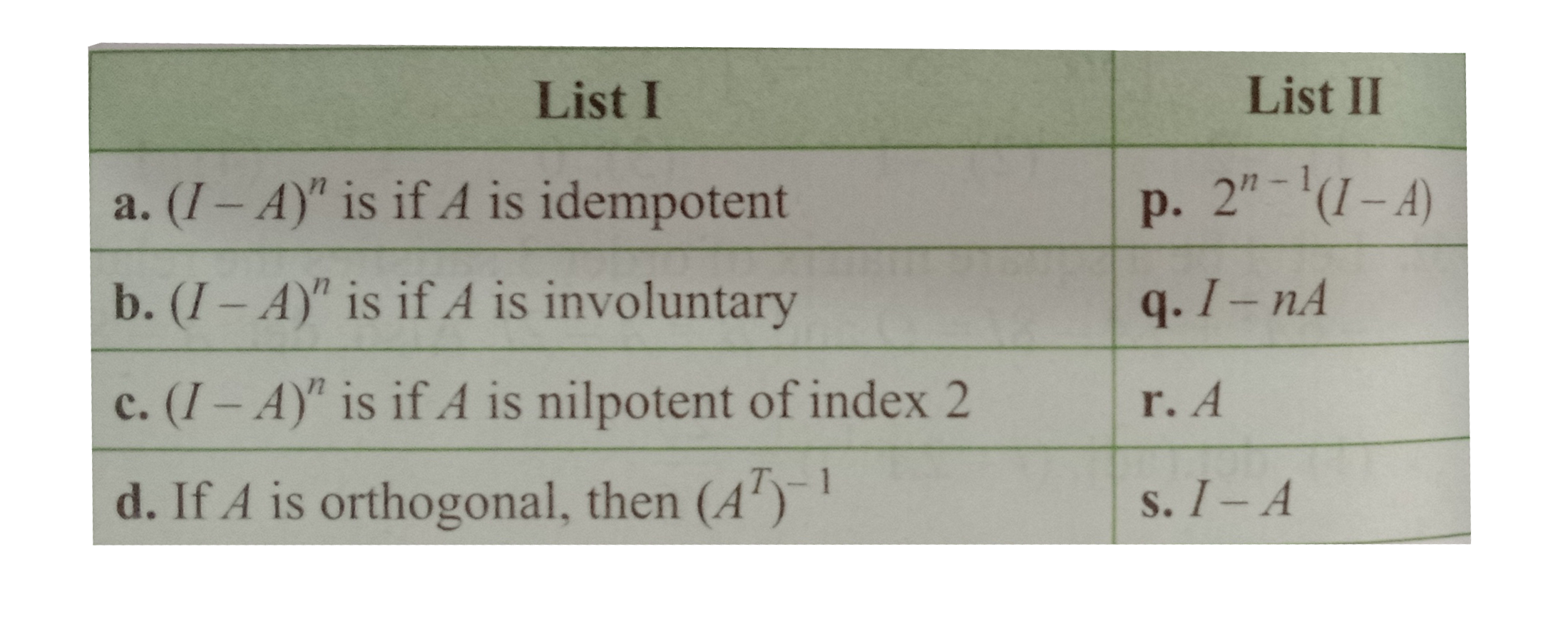If A is an invertible matrix, tehn (adj.A)−1 is equal to adj.A−1 b. Adet.A c. A d. (detA)ASolution in Tamil
adj. (A−1)
Adet. A
A
(det. A) A
A−1=adj (A)|A|
∴(adj A)−1=adj (adj A)|adj A|
=|A|n−2A|A|n−1
=A|A|
Also A (adj A) =|A|I
or A−1(adj A−1)=∣A−1∣I
or A−1(adj A−1)=I|A|
or AA−1(adj A−1)=A.I|A|
or I(adj A−1)=A|A|
or (adj A−1)=A|A|=(adj A)−1
Topper's Solved these Questions
- MATRICESBOOK - CENGAGECHAPTER - MATRICESEXERCISE - Exercise (Comprehension)
18 Videos
- MATRICESBOOK - CENGAGECHAPTER - MATRICESEXERCISE - Exercise (Matrix)
5 Videos
- MATRICESBOOK - CENGAGECHAPTER - MATRICESEXERCISE - Exercise (Single)
65 Videos
- MATHMETICAL REASONINGBOOK - CENGAGECHAPTER - MATHMETICAL REASONINGEXERCISE - JEE Previous Year
10 Videos
- METHODS OF DIFFERENTIATIONBOOK - CENGAGECHAPTER - METHODS OF DIFFERENTIATIONEXERCISE - Multiple Correct Answer Type
7 Videos
Similar Questions
Let a be a matrix of order 2×2 such that A2=O.
A2−(a+d)A+(ad−bc)I is equal to
View SolutionMatch the following lists :

View SolutionIf A is symmetric as well as skew-symmetric matrix, then A is
View SolutionStatement-1: ~(p↔~q) is equivalent to (p↔q).
Statement-2: ~(p↔~q) is a tautology.
View SolutionEvaluate: ∫[√1+x2+x]n√1+x2dx
View SolutionIf A is an invertible matrix of order 2, then det (A−1)is equal to
(A) det (A)
(B) 1det(A)
(C) 1
(D) 0
View SolutionIf A is an invertible matrix, tehn (adj.A)−1 is equal to adj.A−1 b. Adet.A c. A d. (detA)A
View SolutionIf A=([aij])3x3' such that aij={2,,i=j0,i≠j,then |A|=8 (b) ∣∣Adj.A∣∣=32 C+log12(|A|∣∣Adj.A∣∣)=−191 ∣∣∣Adj.Adj.A∣∣∣=1212
View SolutionIf A and B are invertible matrices, which of the following statement is not correct. adj A=|A|A−1 (b) det(A−1)=(detA)−1 (c) (A+B)−1=A−1+B−1 (d) (AB)−1=B−1A−1
View SolutionIf A is an invertible matrix then det(A−1) is equal to (A) 1 (B) 1|A| (C) |A| (D) none of these
View SolutionIf matrix A=[abcd], then |A|−1 is equal to
View SolutionIf A=[abcd] is invertible,then A−1
View SolutionIf A is an invertible matrix of order 2, then det (A−1)is equal to
(A) det (A) (B) 1det(A) (C) 1 (D) 0
View SolutionIf A is an invertible matrix of order 3 and |A|=5, then find ∣∣adj.A∣∣.
View SolutionIf A=(cosα−sinα0sinαcosα0001), find adj.A and verify that A(adj.A)=(adj.A)A=|A|I3.
View SolutionIf A is an invertible matrix, then (adj.A)−1 is equal to a.adj.A−1 b. Adet.A c. A d. (detA)A
View Solution
